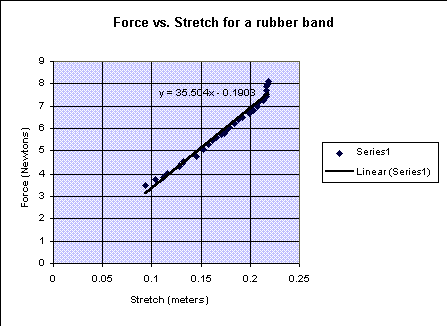Slingshot Physics
Susan Johnston
Problem:
- To determine the elasticity pattern in a common rubberband.
- To determine the energy transfer in a simple slingshot.
Introduction:
In a typical slingshot the kinetic energy obtained by the moving object is obtained from the potential energy of the stretched rubberband and elasticity of the wood launch device. In this experiment you will make a simple slingshot device. After obtaining several characteristics about the elasticity of the device, you will determine the distance a projectile will travel after being launched from the slingshot device.
Safety Note:
As in all laboratory experiments it is crucial to follow the directions stated and not to partake in any actions which may jeopardize your safety or the safety of your classmates or your teacher. Failure to follow these rules will result in serious action.

Materials:
rubberbands
bean bags
ring stands
C-clamps
TI-82 graphing calculator
CBL unit
student force probe
motion detector
spreadsheet program
Procedure/Analysis:
- Set up the equipment as shown. Cover the motion detector on the floor with a metal screen provided. Keep your fingers on the far side of the force probe away from the motion detector.
- Plug the motion detector in the sonic port of the CBL. Plug the Student force meter in CH1 of the CBL.
- Choose the program PHYSICS from your prgm section in the calculator. In the main menu choose Set up Probes. Enter appropriate probes and their ports. Use either stored calibration or calibrate your own sensor.
- Pull straight down with the force probe. Be careful to keep your hands above the probe.
- Is this data repeatable with the rubberband? Prove it.
Lab Check
- Use the TI graph link cable and down load your data directly into Graphical Analysis. Save on your disk. Determine a best fit curve for your data.
- Does this equation fit your expectations? Explain.
- From your graph of force vs. distance you can determine the potential energy of the slingshot. Determine the potential energy stored in the slingshot for 3 positions.
- If you shot a bean bag straight up from these three positions with this simple slingshot, how high up would it go? (hint: you might need the mass of the bean bag.)
Lab Check
- Check your estimate with either a meterstick or a motion detector on the CBL. What error did you find in your estimate? Where did the error come from?
- With a few initial conditions, can you predict how far your slingshot would send a bean bag in the purely horizontal direction? State your initial conditions and make an estimate how far the bean bag would travel. Check your accuracy (reread safety instructions above.)
Analysis:
Here's a sample graph:

Written by Susan Johnston, July 1997


